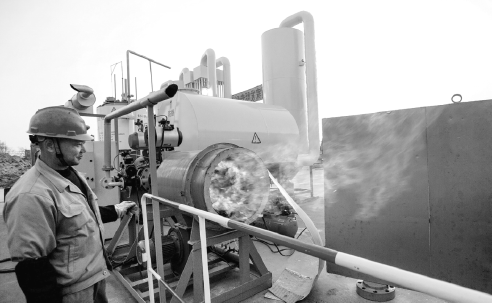Powering a cleaner, brighter future with biogas
China considering more measures to increase the use of less-polluting fuels and achieve sustainable development goals

Instead of hauling urban waste to landfills, China is hoping to turn the trash into a billion dollar business.
Organic waste such as food scraps, animal waste, and agriculture crops can be decomposed to produce a mixture of methane and carbon dioxide. They can soon become an important renewable energy source and be used for heating or powering your car.
More importantly, the waste-derived biogas produces clean fuel without polluting emissions, helps reduce the country's heavy reliance on fossil fuels like coal and oil and produces fertilizers for crops.
That's a large part of the reason why the Chinese government is increasing its bet on the industry to diversify energy sources and curb carbon emissions.
Last December, the National Development and Reform Commission and nine other central departments rolled out new guidelines to support the country's biogas growth.
Measures include prioritizing the use of biogas, launching favorable tax plans, encouraging improvements in the industrial chain, and many others.
The goal was to expand biogas production to over 10 billion cubic meters by 2025 and over 20 billion cubic meters by 2030.
That means the emerging industry will play an increasingly important role in China's energy sources. A report by Sinolink Securities estimates China's natural gas consumption is likely to hit 476.6 billion cubic meters by 2025.
"China has an abundant source of organic waste ... about 2.2 billion metric tons of animal waste and about 700 million tons of agriculture crops... well enough to support the production goals. Our estimation is even more positive. Those organic wastes can support biogas production of about 160 billion cubic meters," said Zhang Dayong, secretary general of the China Biomass Energy Industry Promotion Association.
China started attempts on this front several years ago. From 2015 to 2017, the Chinese government has been offering financial support to scale production of biogas and has supported 63 projects in total.
However, only five have started commercial operations by 2017, with annual gas production reaching about 57.6 million cubic meters. In 2019, China's production of biomethane is estimated at 60 million cubic meters.
"China is still at a very early stage in developing the biogas industry," Zhang said.
"Tech barriers, a lack of successful business models, high production costs and low profit returns... those problems are hindering China's biogas development," he said.
Zhang said that further technological breakthroughs are needed for more advanced production in the industry. He said at this time, methane accounts for 50-70 percent of biogas produced, far lower than the industry standard of 90 percent.
"That means much of what is produced (biogas) cannot be pumped into natural gas pipelines," Zhang said.
Aside from technological barriers, Lin Boqiang, head of the China Institute for Studies in Energy Policy at Xiamen University, said a lack of successful business models are also causing problems.
"Take recycling agricultural crops as an example. Many farmers would rather burn crops down than selling to biogas producers. For one, transportation costs are very high and the crops need a large space to be transported and stored. For another, those crops are hard to sell at a very high price. Farmers would give up recycling crops and selling to biogas producers if they found the whole process cannot make ends meet," Lin said.
"In addition, investments in research and development of biogas projects are usually high and need a long time before harvesting profits. Biogas projects also need trained professionals from various fields including agriculture, environment protection, energy, and fertilizers. All those requirements have set a high bar for investors who want to step into the field," Zhang said.
"Lower-than-expected profits in China's current biogas industry have also made investors less interested," Zhang said, who added that about two-thirds of industry revenue for biogas comes from turning waste into fertilizers, rather than producing energy.
Despite the fact the country has recorded great achievements in the research of biogas fermentation and equipment manufacturing, there is still a gap in tech innovation between China and other countries that are in the forefront of the industry, Zhang said. Chinese project operators can learn some advanced methods from overseas.
Zhang cited the European Union as an example. The EU has set up a series of industry standards to support biogas production and commercial operations. Its standards cover areas of equipment manufacturing, construction, security, hygiene, environmental protection, emission, quality checks, equipment maintenance, grid transportation, and many others.
EU governments have introduced a series of supportive measures. In Sweden, the country has been offering subsidies to biogas plant construction to encourage related projects.
EU countries have also set up biogas consumption goals. Germany said it plans to consume 10 billion cubic meters of biogas by 2030. Sweden made a plan for biogas consumption accounting for 50 percent of total gas consumption by 2020, and 100 percent of total gas consumption by 2050.
"The biogas industry is set for rapid growth on a global scale. There are many experiences that Chinese biogas producers can refer to," Zhang said.
At the early stage of development with annual biogas production lower than 3 billion cubic meters, government subsidies are needed for Chinese biogas producers to guarantee profits and hedge investment risks so that the industry can attract more investors, Zhang said.
Despite the fact that biogas development in China faces great challenges, the sector is still poised to grow and is expected to generate great value, Lin said.


Today's Top News
- Xi, Tokayev attend ceremony of exchanging cooperation documents
- DPP's restrictions sellout of island's interests
- Astana Summit forges strong bulwark against increasing global turbulence
- Xi meets Kazakh President Kassym-Jomart Tokayev
- Xi arrives in Astana for China-Central Asia Summit
- Xi leaves for 2nd China-Central Asia Summit






























